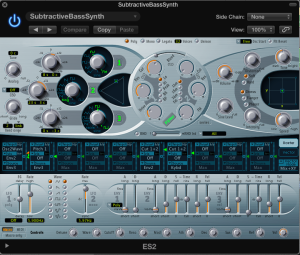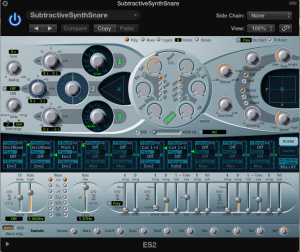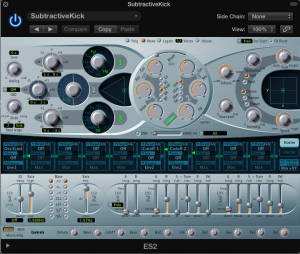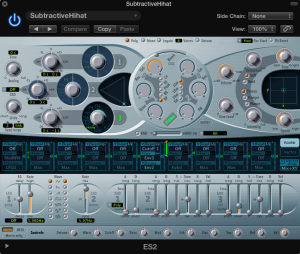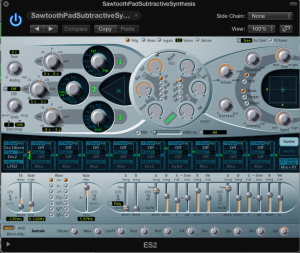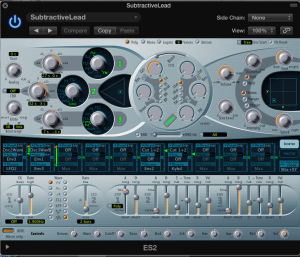Sup people.
Today I tried my hand at some subtractive synthesis. This was supposed to be an over the week task but unfortunately I was suffering from a cranking ear infection, so I figured I would rest up and tackle it at a later date. The date was surprisingly today! Normally I would procrastinate and put it off for as long as possible but I found myself keen to get back ahead of the curve. Let’s crack on then shall we?
The brief was to create a short arrangement of 4 tracks, 2 of which needed to be created using our own custom subtractive synthesis patches. I figured bugger that I am gonna make all the sounds using subtractive synthesis.
I used Logic X and the default subtractive synth, the ES2. This was my first time really working with the ES2 and I must say that it is not a friendly interface for a beginner to synthesis.
To start I headed straight for making a kick drum sound. This quickly turned into making a bass synth. I had the idea of what I wanted to achieve in making a kick but something I did made it sound quite good for a bass synth. I added an oscillator that to me sounded quite like the buzz of a guitar string. So I left it that way and tweaked a little and arrived at my end result.
After the bass I was keen to try to create a snare sound. I knew that I would have to have the buzzing of the snare wires and a sharp attack to emulate a real snare. I used different oscillators to create the individual sounds. You can see that oscillator three is where the white noise is being generated and is being articulated by the third envelope. I feel like I could work on this sound and create a better version, but for this purpose it suit just fine.
Now is when I created the kick sound. I am quite unhappy with what I came up with. I tried using different oscillators and filters to try to get the higher frequency click that would be the beater hitting the drum skin, but I just couldn’t grasp how to get the sound I was after. The sound is far too low even for a kick drum, when I added the bass it could barely be heard. I tried to alleviate this with side chaining but it didn’t do much. Because I couldn’t get the typical kick sound I went for something a bit more abstract.
The final part of my drum kit to make was a hi hat. This was quite simple. Using white noise as the basis (similar to the snare drum) I set out to make my hi hat sound. Using just one oscillator generating white noise and adding a couple of envelopes to shape the sound, I was able to create a very passable hi hat sound. So much so that I showed it to a friend and he asked me how I mic’d my hi hats to get it to sound that way. I had a chuckle.
The next patch I created was intended to be some kind of airy pad to add some ambience. I did end up creating a pad but it was far from airy. I called this the Sawtooth Pad and for good reason. It is this sort of eerie grating sound that I quite enjoyed and can see a use for in the future. What exactly I don’t know. I used the pad to create some space in between the lead sections. What a great segue, off to the lead synth.
Finally I created the Lead synth. This is the only patch where I didn’t have a clear-cut idea of what I wanted. I knew I wanted something to act in the lead role, so it needed to have some higher frequencies (everything else I had made was way too bassy), be able to be “plucked”, while also fitting in with the other instruments. I cranked the pitch of the oscillators up a lot higher than everything else and got to work messing with envelopes to create a sharp plucked sound. The end result I quite like. It does some strange high frequency things if you hold the notes for too long though. Not bad (kinda bad), just strange.
Subtractive Synthesis is pretty bloody cool
In the end I found this to be a very rewarding experience. It proved that my time management skills are getting better as I didn’t have the urge to just put off the whole damn thing, instead I was keen to get it done and dusted. Subtractive synthesis as a whole is such a new world to me that I feel I have only just cracked the surface. Something I would like to improve on is my music theory understanding. If I knew more about scales and chords I would feel much more comfortable about using synthesis to create musically pleasing sounds. Lastly here is the arrangement that I created this afternoon after class.
32 Bar Subtractive Synthesis Arrangement
LO Coverage is hopefully all the ones covered in the week 2 homework assignment. (3, 4, 5, 6, 8, 13 and 16)
Cheers,
Alex
